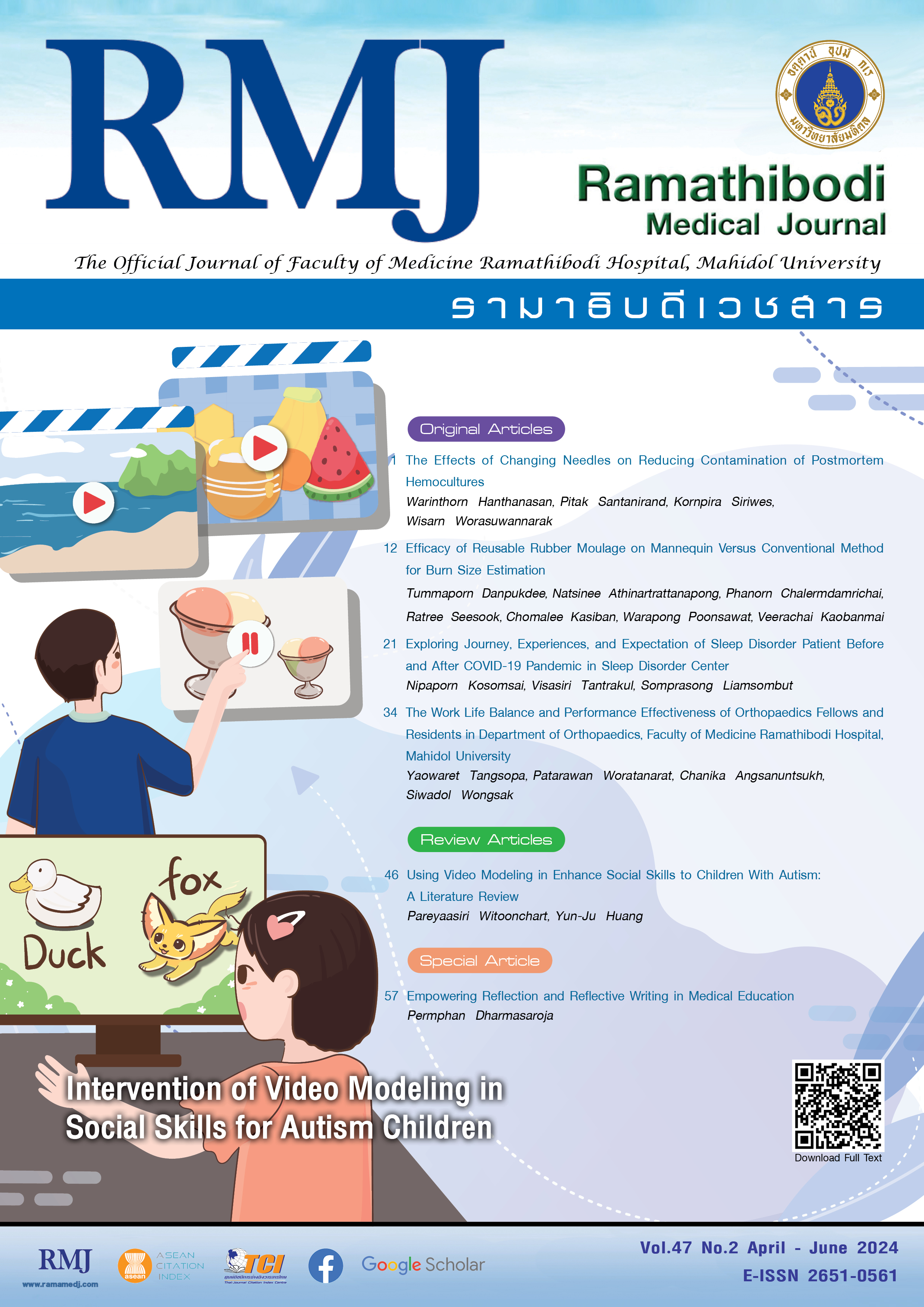Efficacy of Reusable Rubber Moulage on Mannequin Versus Conventional Method for Burn Size Estimation
DOI:
https://doi.org/10.33165/rmj.2024.47.2.266672Keywords:
Moulage, Burn estimation, Emergency medicineAbstract
Background: Burn size estimation is crucial to burn fluid resuscitation. Therefore, training and practice to improve the accuracy of burn size estimation is important. Using reusable rubber moulage (RRM), the newly developed equipment to cooperating with simulation might help improve the accuracy of burn size estimation compared to conventional picture illustration.
Objectives: To compare the accuracy of burn size estimation in simulation between picture illustration and RRM application, and to validate the face and content validity of RRM.
Methods: Medical students, ER residents, EP staff, and paramedics were recruited and randomized into 2 groups. Each group completed 2 different burn pattern stations consisting of one RRM-decorated mannequin station and one picture illustration station. The estimation of total body surface area (TBSA) percentage was statistically analyzed to determine the difference between the 2 methods. Face and content validation were analyzed by a Likert scale.
Results: A total of 70 participants were recruited. The means of total %TBSA of pattern 1 from RRM and picture illustration were 42.29% and 41.24% (P = .61), respectively. The means of pattern 2%TBSA estimation were 41.24% and 42.65% (P = .34), respectively. Participants rated RRM quality by Likert scale with means score more than 4 out of 5 in all questions. Written comments showed a preference toward RRM.
Conclusions: There were no significant %TBSA differences between RRM decorated mannequin and picture illustration in terms of %TBSA. However, participants were satisfied with RRM quality and preferred RRM decorated mannequin.
References
World Health Organization. Fact sheets: burns. Updated October 13, 2023. Accessed December 13, 2023. https://www.who.int/news-room/fact-sheets/detail/burns
Social and Quality of Life Database System, Office of National Economic and Social Development Council. Thailand conflagration annually report 1989-2018. Updated June 13, 2019. Accessed December 13, 2023. http://social.nesdc.go.th/SocialStat/StatReport_Final.aspx?reportid=3673&template=2R1C&yeartype=M&subcatid=48
Snell JA, Loh NH, Mahambrey T, Shokrollahi K. Clinical review: the critical care management of the burn patient. Crit Care. 2013;17(5):241. doi:10.1186/cc12706
Pham TN, Bettencourt AP, Bozinko GM, et al. Advanced Burn Life Support Course: Provider Manual 2018 Update. American Burn Association; 2018:16. Accessed December 13, 2023. https://ameriburn.org/wp-content/uploads/2019/08/2018-abls-providermanual.pdf
The Medical Council of Thailand. Announcement: Medical Competency Assessment for National License 2012. Accessed December 13, 2023. https://www.tmc.or.th/service_law03.php
Parvizi D, Kamolz LP, Giretzlehner M, et al. The potential impact of wrong TBSA estimations on fluid resuscitation in patients suffering from burns: things to keep in mind. Burns. 2014;40(2):241-245. doi:10.1016/j.burns.2013.06.019
Felix HM, Simon LV. Moulage in Medical Simulation. In: StatPearls. StatPearls Publishing; 2022.
Pham C, Collier Z, Gillenwater J. Changing the way we think about burn size estimation. J Burn Care Res. 2019;40(1):1-11. doi:10.1093/jbcr/iry050
Harshman J, Roy M, Cartotto R. Emergency care of the burn patient before the burn center: a systematic review and meta-analysis. J Burn Care Res. 2019;40(2):166-188. doi:10.1093/jbcr/iry060
Harish V, Raymond AP, Issler AC, et al. Accuracy of burn size estimation in patients transferred to adult Burn Units in Sydney, Australia: an audit of 698 patients. Burns. 2015;41(1):91-99. doi:10.1016/j.burns.2014.05.005
Smith K, Poterlowicz K, Southern S, Mahajan AL, Jivan S. The effect of a known object in a static image of a burn to improve the burn size estimation. Burns. 2021;47(6):1295-1299. doi:10.1016/j.burns.2020.12.023
Mills BW, Miles AK, Phan T, et al. Investigating the extent realistic moulage impacts on immersion and performance among undergraduate paramedicine students in a simulation-based trauma scenario: a pilot study. Simul Healthc. 2018;13(5):331-340. doi:10.1097/SIH.0000000000000318
Pywell MJ, Evgeniou E, Highway K, Pitt E, Estela CM. High fidelity, low cost moulage as a valid simulation tool to improve burns education. Burns. 2016;42(4):844-852. doi:10.1016/j.burns.2015.12.013
Downloads
Published
How to Cite
Issue
Section
License
Copyright (c) 2024 By the Authors. Licensee RMJ, Faculty of Medicine Ramathibodi Hospital, Mahidol University, Bangkok, Thailand

This work is licensed under a Creative Commons Attribution-NonCommercial-NoDerivatives 4.0 International License.

















